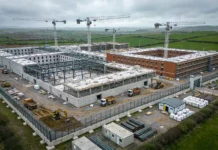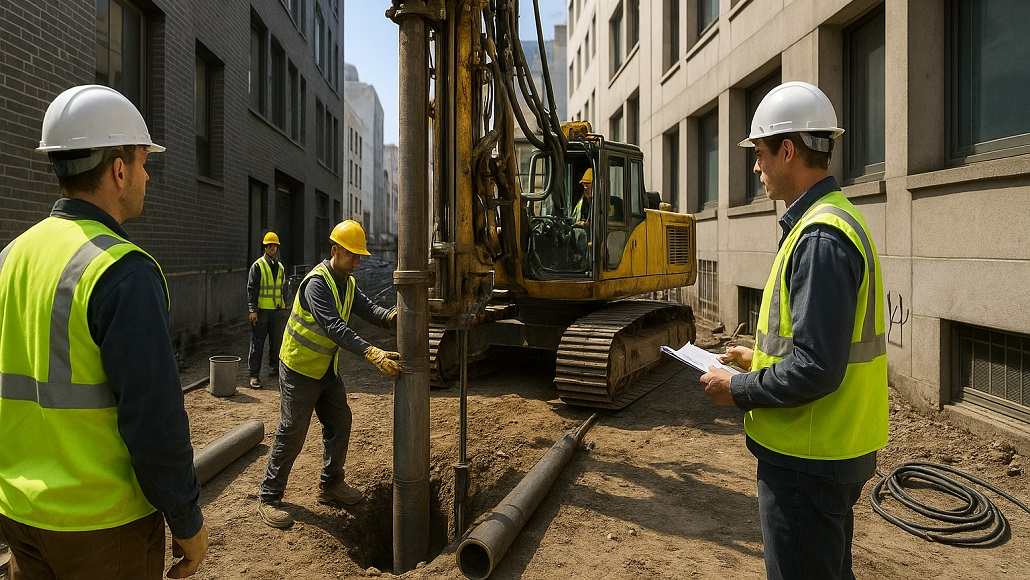The modern construction landscape demands innovative solutions for complex problems. Projects may include significant challenges like limited space and adverse ground conditions. Therefore, industry professionals are relying on innovative approaches and advanced materials.
Could case micropiles be the answer for strengthening foundations? Industry professionals should explore the construction element and its long-term potential.
What Are Cased Micropiles?
Cased micropiles are drilled and grouted foundation elements with a steel casing. Construction professionals use them when the ground is challenging or they have limited access. Workers create them by placing steel pipes into small holes and filling them with grout. Then, they can reinforce the casing with rebar or a central metal bar. Its depth depends on the design requirements.
Cased micropiles have become more relevant in recent decades due to urbanization and infrastructure demands. Evolving drilling technologies, materials and design standards make them more critical worldwide. Construction teams may need them for underpinning, seismic upgrades and retrofitting. Cased micropiles could be a solution in cities that have complex geotechnical profiles.
How Cased Micropiles Could Strengthen Foundations
Complex projects and constrained requirements invite cased micropiles to overtake conventional methods. Here are eight reasons why they could strengthen foundations despite restrictive conditions.
1. Enhancing Stability on Soil Slopes
Construction teams drill micropiles deep into the ground and encounter unstable soil slopes, as the steel pipes effectively stabilize the ground and prevent landslides. A 2023 Journal of Computational Applied Mechanics (JCAM) study used computer simulations to model the slopes and found a 9% increase in the safety factor. The researchers said a simple steel pipe micropile arrangement could be an effective, low-cost alternative for slope stabilization.
Cased micropiles transfer loads from the unstable surface to the more solid strata underneath. Grid or row alignment helps them function similarly to soil nails or mini-piles, thus increasing resistance and rigidity. The JCAM study said implementing steel pipes in the middle of the slope increased stabilization. The ground could include slippery surfaces, so the micropiles are essential in holding the hill in place.
2. Increasing Load-Bearing Capacity
Steel is critical to cased micropiles because it enhances axial strength and load-bearing abilities. Therefore, it can support higher loads than standard elements without casings. The drilled-in piles are permanently in the soil, so they can resist deformation. This characteristic is essential if the soil is weak or loose. Strong bonds between the casing and grout are vital to the capabilities.
Cased micropiles are beneficial in restrictive conditions because they have lateral support. Their small diameters hold well and prevent buckling, which is crucial for foundations in restrictive conditions. Construction teams must also consider steel’s ductility and strength during seismic movement, as it improves performance. This characteristic works well when retrofitting critical infrastructure in urban areas.
3. Minimizing Environmental Impact
Sustainability has become paramount in construction as the industry reduces emissions and environmental impact. Cased micropiles contribute to these efforts through low-vibration installation, which preserves structural integrity. This feature is essential when crews work near sensitive structures like schools and hospitals. Local ordinances may have noise limits, so reducing vibrations is vital.
Another environmental benefit is the minimized site footprint. Restrictive sites need nondisruptive foundations for the surrounding environment. Cased micropiles help these efforts because their equipment is compact and maneuverable. Construction professionals can work in tight spaces and keep nearby trees intact. Therefore, their tree removal and site-clearing impact are lower. Steel casings are vital during installation because they limit fluid migration into the groundwater.
4. Fitting in Tight Spaces
Traditional pile-driving equipment requires sizable overhead clearance and workspace, which can make projects more complex. Cased micropiles’ compact composition helps them access confined spaces and minimize site disruption. They are a go-to solution for entering crawl spaces, infill sites and the area between closely spaced buildings. Construction teams can angle their micropiles as needed while drilling from within buildings.
Cased micropiles offer more flexibility for teams during installation. Construction professionals can integrate them vertically or at various inclinations through battered piles. This maneuverability lets them navigate underground utilities and existing foundations while maintaining structural integrity. Urban settings may have subsurface congestion, making cased micropiles essential for tailoring to the available space.
5. Reducing Downtime
Smaller equipment helps crews work more efficiently despite limited headroom and tight spaces. Cased micropiles have reduced diameters and modular components, so workers can quickly mobilize inside basements or underneath structures. Projects can take less time if they are free of other obstructions. If unexpected subsurface conditions arise, teams can quickly adjust and prevent redesigns.
Crews using cased micropiles can spend less time on site preparation because fewer machines are necessary. They work without heavy cranes or extensive staging areas, so the drilling process typically produces less spoilage and vibrations. Construction teams can focus on the big picture instead of setup, cleanup and restoration. Quiet operations and minimal vibrations mean other workers can focus on interior renovations or aboveground work.
6. Working across Soil Types
A jobsite’s restrictive conditions may include different soil types. Loose fill, soft clays and dense sands could inhibit the construction crew’s capabilities on their project. However, due to their steel casings, cased micropiles are excellent solutions. Metal composition lets them penetrate boulders and debris while supporting boreholes. This backing stabilizes the soil and reduces the risk of collapse.
Typical approaches are less effective when liquefiable soils are present. However, engineers can adjust the casing length and diameter based on the site’s specific conditions. Cased micropiles are helpful during urban infill projects, especially if soil conditions are unpredictable. Bridge and tunnel worksites may have variable ground, making cased micropiles vital due to their flexibility.
7. Accommodating Drilling Options
Cased micropiles also offer flexibility through drilling options. Engineers can leverage their versatility for different techniques, depending on the conditions and site restraints. Rotary drilling cuts through soil and soft rock to work with most soil types. However, it can also suit percussive drilling needs if the location includes denser ground or cobblestone.
This approach accommodates multiple soil conditions and angles, including oblique installations. Construction teams can angle their steel-cased micropiles to resist lateral loads and reinforce foundations against settlement risks. They could use casing advancement systems for simultaneous drilling and casing, thus minimizing disturbances and maintaining structural integrity.
8. Offering Durability
Cased micropiles are essential when extra durability is necessary to complete projects. While steel is strong, grout encapsulates the casing and mitigates corrosion. This protection makes waterlogged or chemically aggressive soil less likely to affect the foundation. Engineers can go the extra mile by using high-strength steel and engineered grout to withstand long-term loading and environmental stressors.
Durability is a crucial micropiling feature in the long run. Engineering strategies like drilling benefit the foundation by reducing vibrations and disturbances. Therefore, the cased micropiling is less likely to face microcracking or settlement that compromises structural integrity. Construction professionals benefit from durability during load transfer, as the steel casing and grout hold under cyclic or seismic loading.
The Challenges of Cased Micropiles
Minipiles offer advantages in restrictive and complex environments, though there are challenges. Here are three hurdles that industrial professionals may encounter in their projects.
1. Life Cycle Challenges
Cased micropiles are relatively new in the construction industry, rising in prominence during the second half of the 20th century. Industry professionals have less experience with them than with driven piles or drilled shafts, so less is known about their life cycles. Once more data is published, engineers and contractors may better understand their performance and maintenance needs.
Considering its corrosion vulnerability, steel is a primary challenge for the life cycle. Aggressive soil and high groundwater can make the metal more susceptible, requiring additional solutions. Construction teams may integrate high-quality grout and protective coatings, though these aspects add complexity. Cased micropiles are smaller than traditional means, so workers may find inspection and monitoring more challenging.
2. Cost Considerations
Cost may inhibit cased micropiling projects if the contractors and engineers have tight budgets. Materials could become more expensive when using high-quality steel casing and grout instead of traditional components. Construction teams need specialized drilling rigs and highly skilled operators for these projects, especially in restrictive and urban environments. Therefore, labor expenses may be higher than anticipated.
The jobsite is essential when considering the total expenses. Engineers may encounter unexpected obstructions, such as old foundations and utilities. Therefore, they will need to redesign or drill more slowly. Extra costs could arise when testing and conducting quality assurance. Construction teams may implement sonic logging or crosshole testing, which require specialized equipment.
3. Permits and Regulations
Using cased micropiles may be more challenging if the area has fewer standardized building codes. Engineers and contractors rely on these regulations for guidance, so uncertainty may arise if local codes exclude minipiles. They may need more justification or customized engineering reports to ensure compliance and satisfy the proper authorities.
Some projects may consider cased micropiles as specialty or innovative foundations, requiring rigorous engineering analyses or third-party verification. These extra steps can extend the permitting timeline and increase upfront costs. Projects may be more complicated if they include historic buildings or environmentally sensitive areas, as agencies may restrict installation methods.
Understanding Cased Micropiles in Strengthening Foundations
Cased micropiles are transformative solutions for building foundations in complex environments. Adaptability, load-bearing capacity and minimized site disruption are vital pillars during urban infill and retrofitting.
Construction professionals should consider this approach to balance performance and sustainability. The long-term data is evolving, so contractors and engineers must be proactive and use wise maintenance strategies.





























